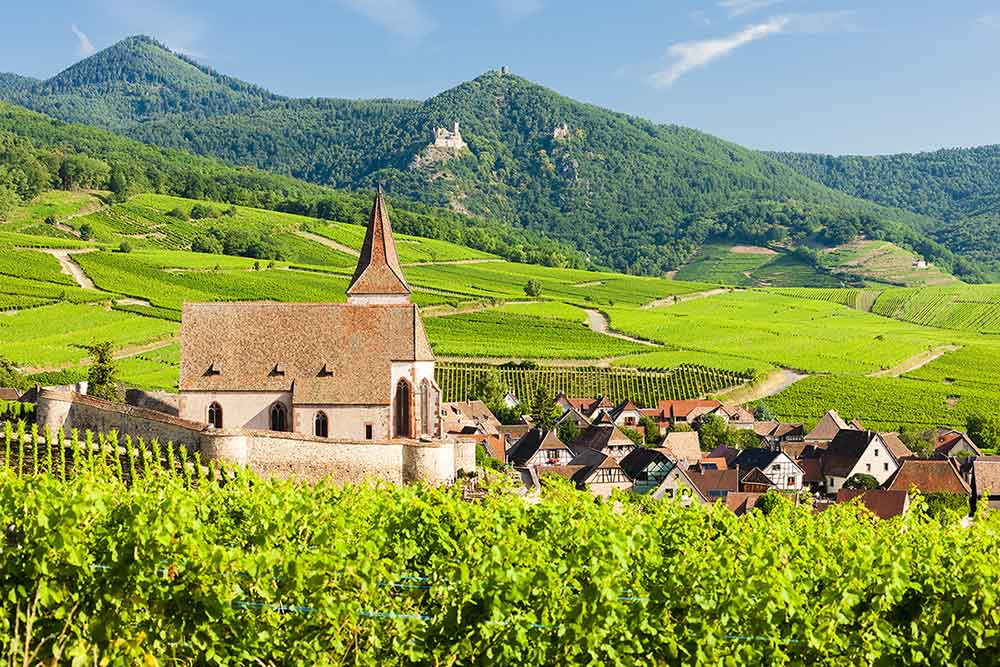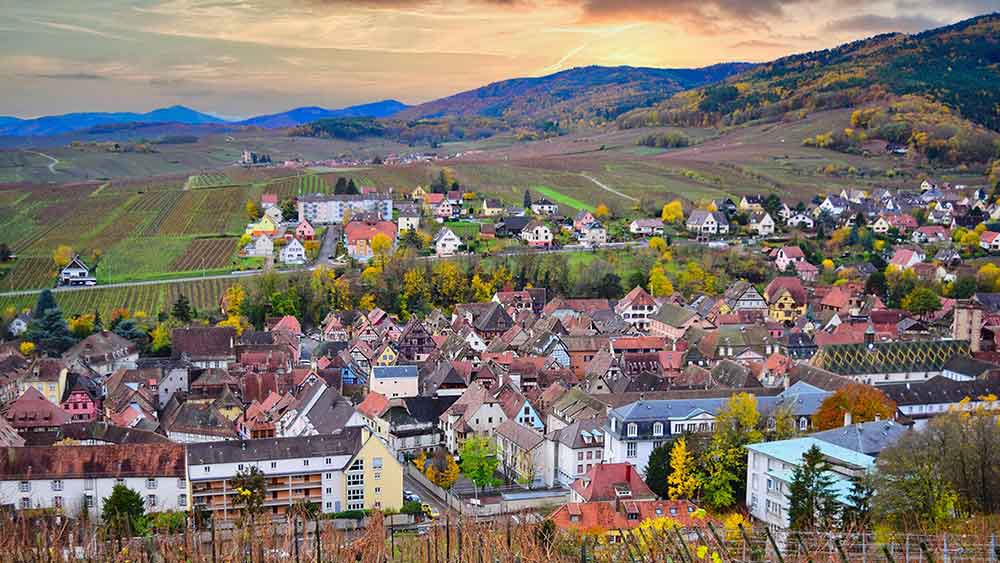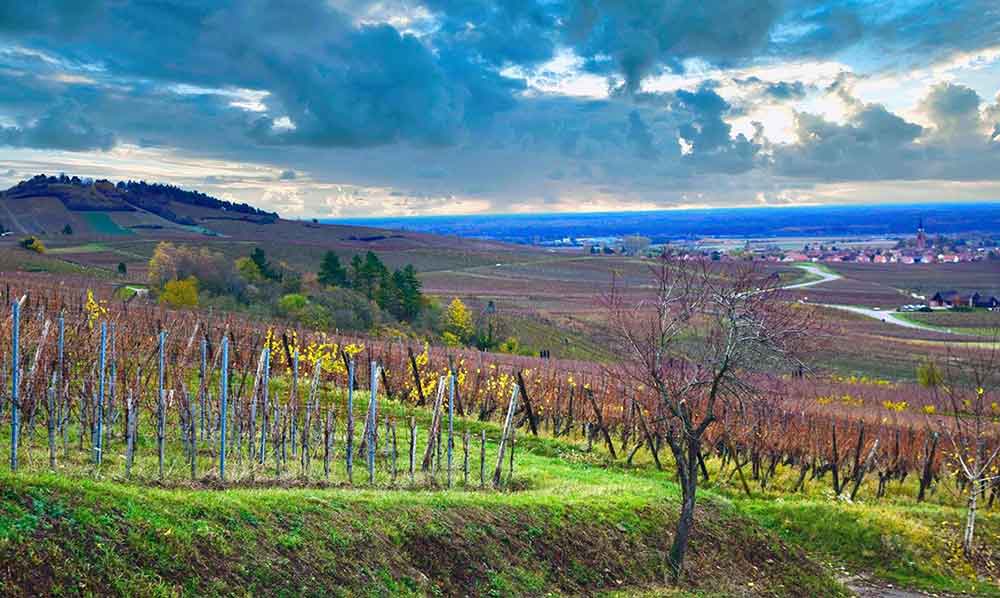 The village of Hunawihr in Alsace.
The village of Hunawihr in Alsace.
Alsace produces some of the great white wines of the world - aromatic and floral, yet textural and crisp. Amazingly, these beautiful wines are often overlooked which is great for astute wine buyers.
Nestled between the Vosges Mountains and the Rhine River, Alsace is located in north-eastern France on the border with Germany. It’s been contested territory for centuries. After becoming German in 1871 it went back to France in 1918 at the end of WWI. Nazi victory over the French in 1940 meant it then went back to Germany, but with the end of WWII in 1945, it once again became French. The region has Germanic and French place names and many locals speak both languages as well as Alsatian dialects.
Alsace has around 37,000 acres of vineyards that run in a narrow strip from near Strasbourg in the north to Mulhouse in the south, a distance of about 100km. In the midst of the vines are several picturesque towns, complete with narrow streets and half-timbered houses, known locally as maison à colombages.
.jpg) Maison à colombages.
Maison à colombages.
The region is a bit of a climatic anomaly. It sits around 48 degrees north, which is the southern hemisphere equivalent of about 550km south of Hobart. Grapes shouldn’t really ripen in Alsace, but it’s the Vosges Mountains, just west of the region, that make it possible. Cool, water-laden westerly winds blow in from the Atlantic and dump their moisture when they hit the Vosges. Just on the other side of the mountains, Alsace enjoys a sunnier, warmer and dryer climate.
Even though it’s now a region of France, it’s no surprise that Alsace is heavily influenced by Germany. Around 90% of wines are white, with riesling being the dominant variety, accounting for over 20% of plantings. The other biggies are gewürztraminer, pinot gris and pinot blanc, but you’ll also find pinot noir, muscat, chasselas, sylvaner, chardonnay and auxxerois.
Unlike the other regions in France, Alsace labels its wine by grape variety and you’ll find both straight varietals and blends. While the region is best known for its dry wines, it’s also known for luscious sweet white wines. Vendanges Tardives indicates late harvest and Sélection de Grains Nobles indicates botrytis affected grapes. The region also produces sparkling wine labelled as Crémant d’Alsace.
Alsace attained appellation status in 1962 and implemented a Grand Cru system in 1975, which identified the best sites. It’s hard to believe that prior to this, there was no geographically based hierarchy of vineyards (like the rest of France), there was simply Alsace. The Grand Cru system undergoes regular revision and there are currently 51 grand crus, accounting for about 4% of production.
I’m pleased to offer you some wines from two of my favourite Alsatian producers; the latest entry level pinot gris from Domaine Jean-Luc Mader and some top-end aged rieslings from André Kientzler.
Domaine Jean-Luc Mader
 Domaine Jean-Luc Mader vineyards in Riquewihr.
Domaine Jean-Luc Mader vineyards in Riquewihr.
Domaine Jean-Luc Mader is a small, family run affair, based in the village of Hunawihr. Sitting on the famous ‘Route des Vins’ in Alsace, the village was founded in the 7th century by one of the country’s first nobles, Lord Hunon and named after his wife Hune. Despite her nobility and wealth, Hune put herself at the service of the village’s poor - lodging them, feeding them and even washing their clothes in the town’s fountain. She was canonised in 1520 and is now known as the saint of washerwomen.
While the Mader estate is based in Hunawihr, it owns a total of 9 hectares of vineyards, spread over four districts: Hunawihr, Ribeauville, Riquewihr and Kientzheim. Of particular note are prized holdings of vines in the famous Rosacker Grand Cru vineyard, as well as the Schlossberg Grand Cru vineyard. The estate produces several wines including a pinot noir, riesling, muscat, gewurtztraminer and of course pinot gris.
Jean-Luc and his wife Anne took over the estate in 1981, but since 2005 their son Jérôme, having studied oenology, has been at the helm. Jerome has converted all their vineyards to bio-dynamic viticulture - so no chemicals, and all vineyard work is carried out by hand. The estate was certified organic in 2007.
Rated top 10 Best Value Producers in Alsace - Tom Stevenson’s Global Report.
“Although Mader’s wines from Grand Cru Rosacker steal the show, his entire line-up is recommended.” Jacqueline Friedrich, The Wines of France.
 Domaine Jean-Luc Mader Pinot Gris 2022
Domaine Jean-Luc Mader Pinot Gris 2022
The fruit for this wine comes off 37-year-old, east-facing vines in the village of Hunawihr. 20% of the wine is aged in old neutral oak and 80% in stainless steel.
This is the estate’s entry level pinot gris - a favourite year-in, year-out and is everything to like about Alsatian pinot gris. In the glass, this is a clear bright gold. On the nose you’ll find juicy ripe pineapple, and gooseberry aromas. On the palate, richer baked pineapple and zingy lemon sherbert notes meld with a lovely chalky minerality. Clean, well-balanced acidity. This is much softer than a riesling, but much more generous and plump in the mouth.
“Good aromatic lift with smoky peach, apple and exotic tropical fruit characters on the nose and palate. The driest Gris we have tasted here yet still round and supple in texture, with wonderfully precise flavour. Great concentration and depth with a tiny residual sweetness in this ripe vintage. The rich texture and cleansing acid balance gives this wine great immediate appeal, yet it also has the structure and depth to age mid-term.” Vintage and Vine.
Delicious drinking.
I can offer it for $39.50 a bottle.
Domaine Kientzler
Kientzler is a small, family run estate situated in Ribeauvillé, a storybook village mid-way between Strasbourg and Mulhouse. The Kientzlers have been here for a long time, best indicated by their ownership of the buildings on all four corners of the main square, as well as many others in the town.
 These days it’s the fifth generation at the helm, with Thierry acting as winemaker and brother Eric looking after the commercial side of the business. The pair epitomise the quiet reserve and confidence that comes with being established in one place for so long. The wines of Kientzler reflect the calm and unassuming nature of their maker - they are fine, pure and intense.
These days it’s the fifth generation at the helm, with Thierry acting as winemaker and brother Eric looking after the commercial side of the business. The pair epitomise the quiet reserve and confidence that comes with being established in one place for so long. The wines of Kientzler reflect the calm and unassuming nature of their maker - they are fine, pure and intense.
“One of the most talented winemakers in Alsace,” Tom Stevenson, The Wines of Alsace.
“One of Alsace’s superstar domaines,” Clive Coates, The Wines & Domaines of France.
“His perfectionist approach means that every wine here is noteworthy,” Andrew Jefford, The New France.
“This estate has established itself for many years as one of the Alsatian references.” Bettane & Dessauve (Bigwig French critics).
On the impressive south-facing slopes that border Ribeauvillé, sit a few castles, as well as the 3 Grand Crus of Geisberg, Osterberg and Kirchberg de Ribeauvillé.
Kientzler has a total of just 14ha (34 acres) of vineyards, which were certified organic as of the 2023 vintage. Of the 14ha, the estate has 4.28ha (10.5 acres) located in the 3 Grand Crus. They’ve chosen not to expand their business, sticking instead to the same vineyards they’ve worked for generations. The Domaine has plantings of seven Alsatian varieties, with riesling and gewürtz making up half of total production.
.jpg) Also in Ribeauvillé is Trimbach and it’s interesting to compare this internationally marketed superstar to Kientzler, who’ve only recently established a website, don’t invite publicity, and aren’t widely sold outside of France. It seems this is the way Kientzler likes it and besides, they don’t need to be well known outside of France. Most of their wine is snapped up by a French cult following, who appreciate the modest prices for top Alsatian wines.
Also in Ribeauvillé is Trimbach and it’s interesting to compare this internationally marketed superstar to Kientzler, who’ve only recently established a website, don’t invite publicity, and aren’t widely sold outside of France. It seems this is the way Kientzler likes it and besides, they don’t need to be well known outside of France. Most of their wine is snapped up by a French cult following, who appreciate the modest prices for top Alsatian wines.
I’m pleased to be able to offer you three Kientzler Grand Cru wines from the 2019 vintage, which was an excellent year for Alsace.
“The 2019s typically displayed a combination of perfume and richness, offset by thrilling acidities; the result of the hot, dry year where everything was concentrated, both the fruit and the acids; the wines have a delicious energy.” Decanter Magazine.
These wines have a few years age on them and are drinking beautifully now. The current releases are all more expensive.
.gif) Domaine Kientzler Riesling Grand Cru Osterberg 2019
Domaine Kientzler Riesling Grand Cru Osterberg 2019
As the name suggests, Osterberg, meaning east hill, faces predominantly east. The vineyard sits above Geisberg and gained Grand Cru status in 1992. It’s 24.6ha, of which the Kientzlers own 1.15ha. The vines here are in excess of 50 years old and deliver a tight and very mineral riesling. Eric Kientzler describes Osterberg as “the most classic Grand Cru in our portfolio.” This 2019 finished at 13.5% alcohol and is dry.
“...the Osterberg is more classic and flinty, requiring longer in bottle.” Tom Stevenson - The Wines of Alsace.
“So tight and firm with major, chalky minerality, this is a very striking dry riesling that has the depth of expression we expect from the Grand Cru category wines. So much Amalfi lemon and lemon curd, but also dill and parsley aromas. Serious depth and structure at the bold and crisp finish. Drink or hold.” 94 points, jamessuckling.com, June 2022.
(If you’re like me and don’t know what an Amalfi lemon is - they’re the ones that have the protruding pointed ends. They have a thick skin, a more intense fragrance and are highly prized for their use in cakes and limoncello.)
96/100 points, Bettane & Desseauve 2022.
94/100 points, Le Guide des meilleurs Vins de France RVF 2022.
I can offer it for $79 a bottle.
.gif) Domaine Kientzler Riesling Grand Cru Kirchberg de Ribeauvillé 2019
Domaine Kientzler Riesling Grand Cru Kirchberg de Ribeauvillé 2019
Kirchberg means church hill, derived from the Church Saint-Grégoire which sits at the bottom of the hill. Kirchberg de Ribeauvillé was granted Grand Cru status in 1983 and the 11.4 ha site, of which the Kientzlers own 1.63ha, is the highest and coolest in the village, sitting closest to the forest. Rieslings from this site tend to be some of the finest, freshest and raciest in Alsace.
Eric Kientlzer notes: “The 2019 here is very much in the mould for the vineyard with very fine tight citric fruit and a great line of acidity with about 2g/l more acidity than for the 2018 vintage.” The 2019 finished at 14% alcohol and is dry.
“Such a deep nose of lemon curd and fresh sage with just a hint of melted butter. Powerful and highly structured on the full-bodied but super-clean palate, this has stunning mineral intensity that builds and builds at the very sharply defined finish. Drink or hold.” 96 points, jamessuckling.com, June 2022.
95/100 points, Bettane & Desseauve 2022.
95/100 points, Le Guide des meilleurs Vins de France RVF 2022.
I can offer it for $95 a bottle.
.gif) Domaine Kientzler Riesling Grand Cru Geisberg 2019
Domaine Kientzler Riesling Grand Cru Geisberg 2019
Geisberg is regarded as one of the great Grand Crus of Alsace. It gained Grand Cru status in 1983 and the 8.53 ha site is the third smallest Grand Cru in Alsace. It has only 4 owners, one of which is the Kientzlers, who own 1.5ha. The south facing site, rises steeply from the northern edge of Ribeauvillé and is dotted with stone walls supporting narrow terraces. It produces the most powerful and cellarable wines of the three Ribeauvillé Grand Crus.
The Australian importer of Kientzler told me a great story about Marc Hugel, current winemaker at the iconic Hugel estate. When quizzed about the best Alsace he’d tried, he referenced a 1937 Kientzler Geisberg. Wow.
“The Geisberg is immense and rivals with the greatest wines of the world.” Les Meilleurs Vins de France.
“Geisberg has been well documented since 1308 as Riesling country par excellence. The wines are fragrant and have great finesse, yet they are also powerful and long lived. These are true Grand crus, not widely available and highly sought after. Andre Kientzler is the greatest exponent of Geisberg Riesling.” Tom Stevenson, The Wines of Alsace.
Geisberg translates to ‘goat hill’. But the official Alsace website also offers: “According to another approach, some believe this Grand Cru name stems from ‘spirit’ (coming from Geist in German), not the malevolent spirit but that which appears when tasting a good wine, allowing to say to German wine-lovers ‘Dieser Wein hat Geist’ meaning this wine has body.”
Either way, until a few years ago Geisberg had five owners; Trimbach, Kientzler, Faller, Baldenbeck and the local monastery. But the nuns decided to sell their holding to Trimbach. Of the remaining four, only Faller and Kientzler make ‘pure’ riesling grand Cru Geisberg. Trimbach makes a blend, and the others sell their fruit.
The Kientzler 2019 is 14% alcohol and is dry.
“The aromas of this remarkable dry riesling sparkle like a well-cut gemstone. So much drive and energy are packed into a rather sleek silhouette, the enormous, citrusy freshness and the mineral finish lighting up the sky. Drink or hold.” 95 points, jamessuckling.com, June 2022.
97/100 points, Bettane & Desseauve 2022.
96/100 points, Le Guide des meilleurs Vins de France RVF 2022.
This is a great example of a classic dry Alsatian riesling, one that will age beautifully and one you should definitely have in your cellar.
I can offer it for $110 a bottle.